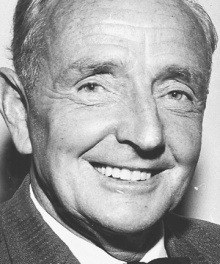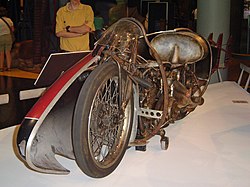Burt Munro
Burt Munro | |
|---|---|
 | |
| Born | Herbert James Munro[1] 25 March 1899 Invercargill,New Zealand |
| Died | 6 January 1978(aged 78) Invercargill, New Zealand |
| Resting place | Eastern Cemetery, Invercargill, New Zealand |
| Occupation(s) | Carpenter New Zealand Home Guard Speedway rider Motorcycle salesman Mechanic |
| Known for | Land Speed record holder |
| Spouse(s) | Florence Beryl Martyn (m. 1927; div. 1947) |
| Children | 4 |
Herbert James "Burt" Munro(Bertin his youth; 25 March 1899 – 6 January 1978) was amotorcycle racerfrom New Zealand, famous for setting an under-1,000 cc world record, at Bonneville, on 26 August 1967.[2]This record still stands; Munro was 68 and was riding a 47-year-old machine when he set his last record.[3]
Working from his home inInvercargill,he spent 20 years highly modifying his 1920Indian motorcyclethat he had bought that same year. Munro set his first New Zealandspeed recordin 1938 and later set seven more. He travelled to compete at theBonneville Salt Flats,attempting to set world speed records. During his ten visits to the salt flats, he set three speed records, one of which still stands.
His efforts, and success, are the basis of the filmThe World's Fastest Indian(2005), starringAnthony Hopkins,and an earlier 1971 short documentary filmBurt Munro: Offerings to the God of Speed,both directed byRoger Donaldson.[4]
Early life
[edit]Munro was born in 1899 to William Munro, afarmerand Lily Agnes Robinson inInvercargill.[5]His twin sister died at birth[2]and Munro grew up on a farm inEdendale,east of Invercargill. His grandfather James Robertson Munro was from northernScotlandand settled on a farm in Invercargill.[5]
Munro's interest in speed began at an early age, riding the family's fastest horse across the farm, despite the complaints of his father. Trips via train to the Invercargill port were a rare source of excitement, and the arrival of cars, motorcycles and aircraft added to Burt's eagerness to join the world outside his farm. As Munro's family discouraged his endeavours outside farm life, he became constantly bored with daily routine. At the outbreak of theFirst World War,he intended to go to war as soon as he was old enough, for a chance to see the world.[1]
Munro remained on the family farm until the end of the First World War, when his father sold the farm. At that time, Munro worked on theOtira Tunnelconstruction until recalled to work with his father on a newly purchased farm.[1]After this he became a professionalspeedwayrider, but returned home to the family farm at the start of theGreat Depression.Finding work as a motorcycle salesman and mechanic, he raced motorcycles and rose to the top of the New Zealand motorcycle scene, racing onOreti Beachand later inMelbourne,Australia.[1]
After theSecond World War,Munro and his wife divorced, and he subsequently gave up work to reside in a lock-up garage.[6]
Challenges
[edit]
Munro'sIndian Scoutwas an early model, the 627th Scout to leave the American factory.[7]The bike had an original top speed of 55 mph (89 km/h),[2]but this did not satisfy Munro, so in 1926 he began to modify the bike.
Munro's two greatest challenges while modifying his bike were his lack of money and that he worked full-time as a motorcycle salesman.[citation needed]He would often work overnight on his bikes (he had a 1936Velocette MSSas well), then he would go to work in the morning, having had no sleep. Being of modest means, he would often make his own parts and tools instead of having them professionally built. He would cast parts in old tins, make his own barrels, pistons, flywheels, and such; hismicrometerwas an old spoke.[2]

In its final stages, the Indian's displacement was 950 cc (as built it was 600 cc) and was driven by a triple chain drive system.[2]
The "Munro Special," as Munro called his bike, is now owned by Neville Hayes, in New Zealand'sSouth Island,and is on display atE Hayes & Sons,Invercargill.[7]
Bonneville Salt Flats and Speed Week
[edit]TheBonneville Salt Flatsin northwesternUtah,US is known worldwide for its many miles of flat, compacted salt; perfect for testing speed machines. DuringSpeed Week,usually in mid-late August, vehicle enthusiasts from around the world gather at Bonneville.
Munro travelled to Bonneville fourteen times, the first 3 times for "sightseeing" purposes. In the nine times he raced at Bonneville,[8]Munro set three world records: in 1962, in 1966 and in 1967. He also once qualified at over 200 mph (320 km/h), but that was an unofficial run and was not counted.
Following the misspelling of his name in an American motorcycling magazine in 1957, Bert Munro changed his name to Burt.[1]
Personal life
[edit]A son of William Munro (1870–1949) and Lily Agnes Munro (1875–1967), he had two brothers and three sisters, Eva, Ruby and the novelist Florence Preston.[citation needed]The accidental death of his older brother at the age of 13 had a profound effect on his life. Munro and Florence Beryl Martyn were married in 1927 and had four children. They were divorced in 1947.
Having hadanginasince the late 1950s, Munro had a stroke in 1977, and was admitted to hospital. He found his coordination had diminished. Frustrated, but wanting his motorcycles to remain in Southland, he sold both machines to his friend, Norman Hayes, of E. Hayes & Sons.[9] Munro died of natural causes on 6 January 1978, aged 78 years. He is buried at Invercargill's Eastern Cemetery, with his parents and brother.[10]
Records/runs
[edit]- In 1962, he set an 883cc class record of 178.971 mph (2 way average) with his engine bored out to 853cc.[2]
- In 1963, during his first run, the Indian's v-twin blew up at over 195 mph (313.882 km/h), ending his S-A 883cc record attempts for 1963. His qualifying run was right before then, during which Burt turned in 183.673 mph (295.61 km/h). His Indian was still at 853cc.
- At Bonneville in 1964, he ran 184 mph qualifying run before bad weather ended speed week for the year. His Indian was now 871cc.
- Bonneville 1965 was a zero year for him, as he had some low speed runs in the high 160 mph range.
- In 1966, he set a 1000cc class record of 168.66 mph (2 way average) with his engine at 905cc. His unofficial top speed was 212 mph (341.181 km/h), his qualifying speed was 172 mph (270.807, km/h).
- In 1967, his engine was bored out to 953cc and he set an under 1000cc class record of 184.087 mph (2 way average). To qualify he made a one-way run of 184 mph then later on he re qualified at 190.070 mph (305.88 km/h). His highest recorded measured mile was 188 mph (302.557 km/h).
- Bonneville 1968 was another not so good year for him. The best he could coax from the Indian was a lousy 155 mph (249.448 km/h) due to magneto issues.
- In 1969, he recorded two runs at 191 mph. He couldn't complete a return run due to unforeseen mechanical issues, which meant no new record. After 14 test runs on the salt in 4 days, he ran out of time. His Indian was now at 965cc.
- Bonneville 1970, he decided to switch his fuel from the methanol which he always ran his Indian on to nitromethane. Even after making several needed adjustments, the v-twin still burned up all his spare pistons. His Indian was bumped up to 985cc.
- At Bonneville in 1971 Burt ran the Indian on the salt for the last time ever. Due to new and very strict streamliner rules, he couldn't run with the fiberglass body. Without the shell the Indian was now seriously over-geared, and he ran his last run at 148.51 mph (239.036 km/h).
- In 1975, he made his 14th and final trip to Bonneville, as a spectator.
- In 2006, he was inducted into theAMAMotorcycle Hall of Fame.[11]
- In 2014, 36 years after his death, he was posthumously awarded a 1967 record of 184.087 mph (296.2593 km/h) after his son John noticed a calculation error by AMA at that time.[12]
Legacy
[edit]Feature filmThe World's Fastest Indian
[edit]Burt Munro was the subject of a 2005 film,The World's Fastest Indian,based on a composite of his Bonneville speed runs. This film depicts a determined old man who, despite facing many difficulties, travels from New Zealand to the USA to test run his motorcycle west of the Great Salt Lake. The disclaimer says: "While this motion picture is based upon historical events, certain characters names have been changed, some main characters are composites or invented and a number of incidents fictionalised."
The Burt Munro Challenge
[edit]Inspired by the 2005 film, the Invercargill Motorcycle Club has held a "Burt Munro Challenge" motorcycle competition annually since 2006 (except 2007, 2017 and 2022). The 2023 event ran for four days, including a hill climb, drag racing, beach racing, sprint, speedway and street racing.[13]
The E. Hayes Motorworks Collection
[edit]The E. Hayes hardware store in Invercargill maintains a free motorcycle museum featuring Munro and his work, including the original "Munro Special" Indian.[14]
2013 Indian namedSpirit of Munro
[edit]In March 2013,Indian Motorcycleannounced that it was producing a custom-built streamliner named theSpirit of Munro.[15]The motorcycle was built to showcase the Thunder Stroke 111 engine to be used in one of the 2014 road models. The company said theSpirit of Munro Scoutwas a tribute to Munro's achievements with the Indian Scout and to all Indians of old.[16]
Notes
[edit]- ^abcdeTim HannaOne good run: The legend of Burt Munro,Penguin Books,2005;ISBN0143019740
- ^abcdef[verification needed]The World's Fastest Indian, The Munro Special. A Tribute to H.J 'Burt' Munro,archived fromthe originalon 23 July 2011
- ^"Bonneville certified bike records".Archived fromthe originalon 24 February 2020.Retrieved27 November2015.
- ^Burt Munro: Offerings to the God of Speedat IMDB
- ^abBirss, Neill (30 May 2016).Burt Munro:The Lost Interviews.Penguin Books Limited.ISBN9781743487204.Retrieved21 November2022.
- ^"A Bike, a Shed, and Burt Munro".tepapa.govt.nz. Archived fromthe originalon 1 October 2009.Retrieved1 July2009.
- ^abE Hayes & Sons websiteArchived25 February 2009 at theWayback Machine
- ^Motor Cycle,20 April 1967, pp. 482–484DragnutbyGeorge Wilson. "Last year marked Bert's[sic]ninth Stateside visit".Accessed and added 22 October 2014
- ^Hayes Motorworks Collection
- ^"Cemetery result".Invercargill City Council.Archivedfrom the original on 8 February 2021.Retrieved8 February2021.
- ^"2006 Burt Munro Challenge".Southland Times photo archive.Invercargill: Fairfax. Archived fromthe originalon 19 August 2010.
- ^Harley, Bryan."Burt Munro Breaks Record 36 Years After Death".Motorcycle USA.Archived fromthe originalon 13 August 2014.Retrieved11 August2014.
- ^ "Burt Munro Challenge".Burt Munro Challenge.Retrieved9 September2023.
- ^https://www.ehayes.co.nz/motorworks-collection/hayes-motorworks-collection-__I.26222"The E. Hayes Motorworks Collection".Retrieved9 September2023.
- ^"Indian Motorcycle 'Spirit of Munro'",BikeEXIF,11 March 2013
- ^Dave Moore (30 March 2013)."World's newest Indian honours Burt Munro".stuff.co.nz.Retrieved30 March2013.
References
[edit]- Burt Munro: Indian Legend of Speed,George Begg (2002)
External links
[edit]- E Hayes and Sons: The World's Fastest Indian Exhibition (original motorcycles), The World's Fastest Indian Legend
- The World's Fastest IndianatIMDb
- Offerings to the God of SpeedatIMDb,a documentary
- Motorcycle Hall of Famebio and photos
- Burt Munro Biographymore detailed biography and photos
- "Hero!" article,courtesy of "Classic Bike" magazine toGranite State BMW Riders
- Burt MunroatFind a Grave
